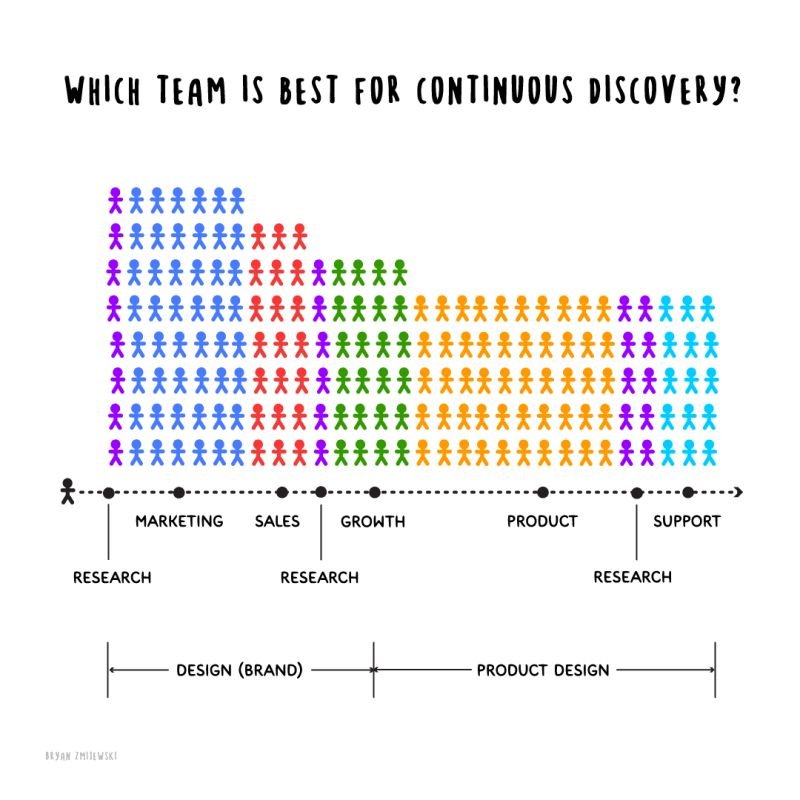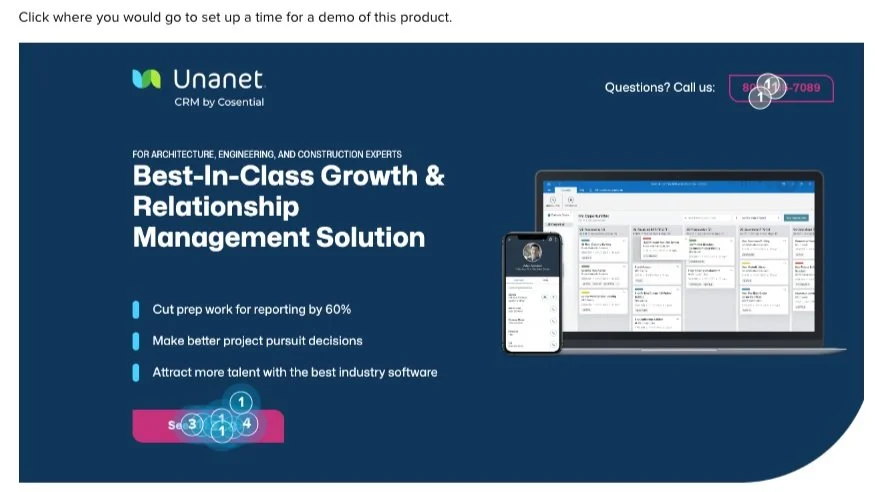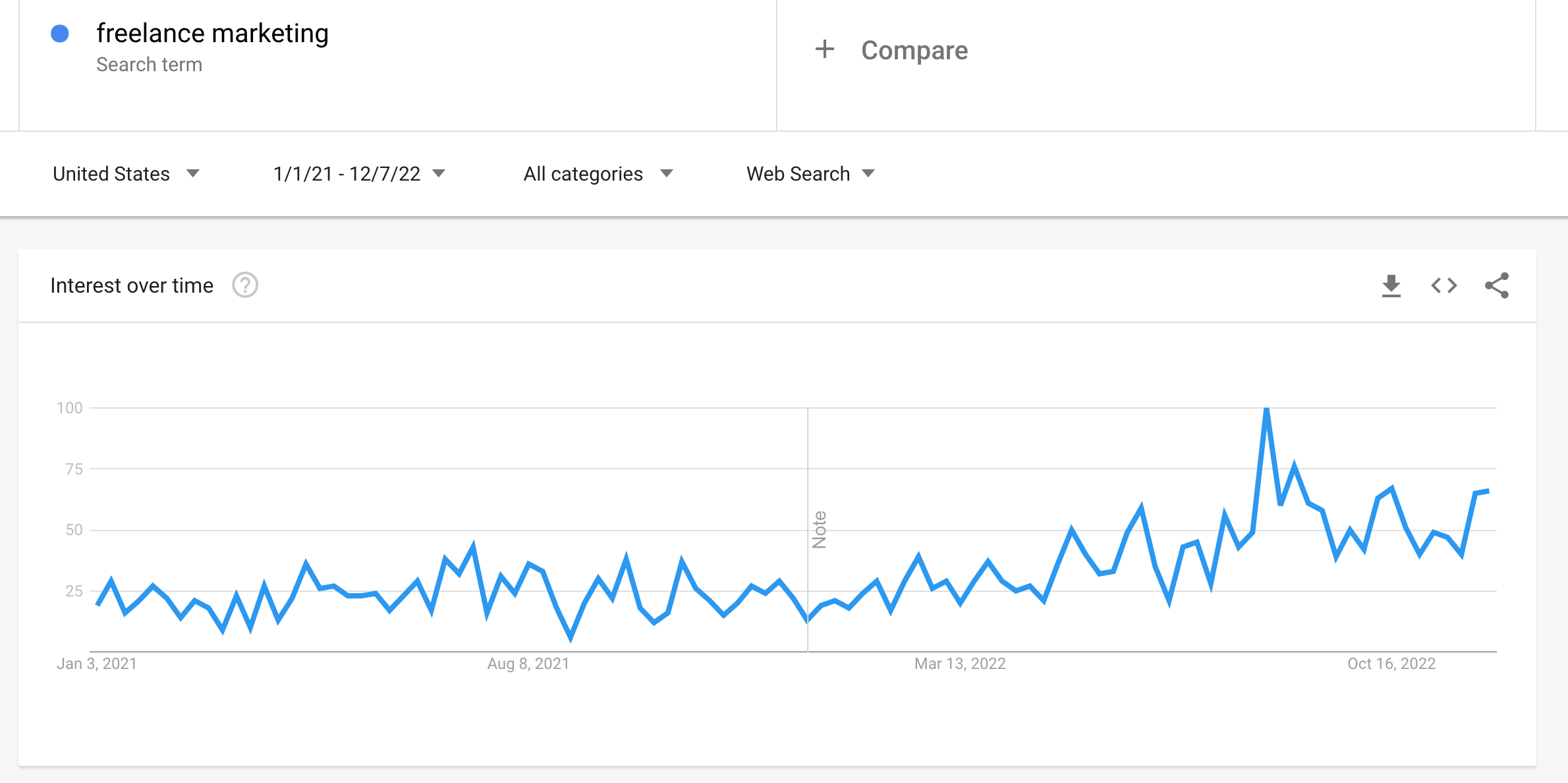B2B Market Research Methods For Audience Insights
Research can be influential. It can fuel your marketing strategy, product, even your brand. Once you’ve identified your target audience, the next step is to select the proper method to source feedback and behavioral data. This article outlines various B2B market research methods your company can use to source audience insights.
B2B Market Research Processes
Traditional Research Process
This is more of a project-based process where a research study is commissioned and carried out by a team of researchers.
Define the purpose and scope of your research
Design the research method
Collect qualitative and quantitative data
Analyze the findings
Summarize critical insights and recommendations
Continuous Research
Another model is less linear and accounts for the purpose of research: to learn about your target audience in order to further the business. This image from Bryan Zmijewski shows how research—of different kinds—is useful for teams all across a B2B SaaS company. The same principles can be applied to other industries and business models, too. Check out his LinkedIn post about the topic.
The research method you select will depend on the kind of data you need.
Primary — This data does not exist. You must go out and source it.
Secondary — This data exists and may be available to you.
Primary B2B Market Research Methods
If you need to collect primary data from your target audience, these market research methods are useful. If you need support collecting primary market research, simply reach out to start a conversation.
Customer interviews
Possibly the most essential and powerful B2B market research method, customer interviews are a direct line to your customers. You have an opportunity to understand the trigger moment that sets them on a course to buy your product or service. You can uncover the “job” customers are hiring you to do. These are the kind of insights that can strengthen your marketing strategy.
However, if you would like honest feedback, consider who is conducting the interview. Your customers may be willing to be more candid with a third party than talking with you or a company representative.
Another strategy is to use a podcast as a way to source interviews with customers and/or prospects. Positioned the right way, a podcast can fuel research, marketing, and sales. If you’re thinking about luanching a business podcast, I put together a free course to show you how:
Focus groups
Focus groups are when a mediator interviews a small group of people representing your ideal customers. This B2B market research method can be an excellent place to test a new product, service ideas, or brand messages.
Selecting candidates for a focus group can be tricky in B2B. Consider customers you have a good relationship with or those you trust to give honest feedback.
Live Q&A
Use live Q&As to collect ideas for new content, features, or service offerings. If you host a live webinar on a topic your audience cares about, reserve part of the webinar time for an audience Q&A period. Chances are, the questions your attendees ask are questions others are thinking about.
Surveys and polls
Launching a survey is a common B2B market research method. Surveys can be used in a variety of ways. Here are a few different use cases:
Net Promoter Score
Client Experience
Employee Experience
Brand Surveys
Topical Research
Here are a few survey tools useful for B2B and professional services firms:
Google Forms — This free tool is great for short, simple surveys.
Qualtrics — This is more of an enterprise solution. XM is great for complex branching logic and integrations with other software.
SurveyMonkey — The platform that can’t shake its primitive name. SM is great for B2B and professional services firms who want to get started with research.
Helio — This is a nice little sweet spot. 12 different question types makes this a legit survey tool, but you also have access to a million survey panelists.
Click Tests
When you need to understand behavior of users online, there are many insights you gan gain from running a click test. For example, this article on responsive landing pages shows click test results from a landing page for Unanet, a CRM for Architecture Engineering & Construction (AEC) firms.
This kind of primary research can be valuable to website designers, product and marketing teams who need to constantly test new things and iterate on ideas.
Secondary B2B Market Research Methods
Stand on the shoulders of giants. There is an ocean of data already available to you. Secondary research is when you source findings from existing data. There are many different B2B market research methods for secondary data.
Mining Customer Reviews
If you’re looking for honest market feedback, consider analyzing your company's and competitors' customer reviews on review sites. Using this B2B market research method, you get qualitative feedback from genuine buyers, and you can see where your competitors fall short—a void you could fill with your product or service. Here are some review sites commonly used in B2B:
Review sites for B2B SaaS
Review sites for Professional Services Firms, Consultants, & Agencies
Online Market Research Tools
Use online tools as part of your B2B market research methodology to source audience insights. This way, you can get a general idea of trends or validate the language and terminology used by buyers to describe their business challenges. Here are a few online tools you can use to gather secondary data on your buyers:
SEMRush — mainly used for SEO, this tool can also be a powerful market research tool to identify competitors and see relative search volume for keyword variations.
SparkToro — this powerful audience research tool curates the publications your audience subscribes to, the websites they frequently visit, and the podcasts they listen to.
ChatGPT — If you haven’t heard of it, ChatGPT is an AI tool that you can ask questions or give commands and it returns text you can copy/paste and use on your own. As of now, ChatGPT is free to users outside peak hours. It can be a useful secondary research tool with many other use cases.
Google Trends — this free tool shows the interest over time for a particular search term. For example, the screenshot below shows that over 2022, interest in “freelance marketing” has grown significantly.
Twitter as a Market Research Tool
If your audience is active on Twitter, it can be a valuable part of your B2B market research methodology. Advanced commands can be used in the platform’s search bar to filter and focus your search.
For example, the command below would curate Tweets for a specific topic between two dates. This could be useful for digging up old Tweets or capturing particular moments.
"topic" since:yyyy-mm-dd until:yyyy-mm-22
You can also isolate tweets from specific accounts that have specific hashtags. Here is how that command would look:
from:@HANDLE #hashtag
LinkedIn as a Market Research Tool
The most popular B2B social media platform is also a potent market research tool. You can use the platform’s search bar to construct account maps, do competitive research, see posts about specific topics, and more.
Social Media Listening Tools
Tools like SproutSocial and BuzzSumo allow you to aggregate and analyze large amounts of user data from platforms like LinkedIn, Facebook, and Twitter. See what topics specific segments of users are talking about and more.
Work with a seasoned market research professional.
Research is a good place to start if you’re looking to get your marketing strategy back on track. I’ve analyzed sentiment from more than 10,000 B2B buyers and sellers and have experience in each of the B2B market research methods in this article.
Please feel free to contact me for a free consultation today.



